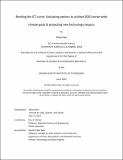Bending the ICT curve: Evaluating options to achieve 2030 sector-wide climate goals & projecting new technology impacts
Author(s)
Bell, Allison
DownloadThesis PDF (4.953Mb)
Advisor
Olivetti, Elsa A.
Terms of use
Metadata
Show full item recordAbstract
The global impact of the information and communications technology (ICT) sector is both growing and changing as computing technologies continue to develop and industry leaders make more efforts towards emissions reductions. Recent work highlights the increasing importance of manufacturing emissions in regards to the total impact of computing systems, but the tradeoff space in which decisions made to reduce emissions or energy in one part of a device lifecycle might increase emissions or energy demand in another remains largely unexplored. We evaluate several options for global impact reduction within the ICT sector, namely within data center (server) and smartphone footprints, focusing both on the maximal potential impact of each intervention and highlighting associated tradeoffs and limitations. We find that the ICT sector’s 2030 target of a 45% emissions reduction from 2020 levels is potentially achievable through the mechanisms proposed, including: renewable energy for operation, low-carbon electricity for manufacturing, extended device lifetimes, and the harnessing of energy efficiency improvements for impact reduction. In addition, we propose a method for evaluating the total carbon footprint benefits of a new computing technology through a detailed case study of a prototypical analog accelerator device. We provide an example of underspecified estimation of scaled device manufacturing impacts obtained through a reorganization of existing process emissions data. We then demonstrate the use of that estimate to evaluate the benefits of adoption of the new technology from the perspective of total footprint reduction under varying device usage conditions. Both our framework for estimating global ICT sector impact reduction strategies and our framework for assessing tradeoffs associated with new computing technology adoption are intended to serve as starting points for continued discussion and to align different, often siloed, stakeholders within the computing industry towards effectively “bending the curve” of ICT sector emissions growth.
Date issued
2023-06Department
Massachusetts Institute of Technology. Institute for Data, Systems, and SocietyPublisher
Massachusetts Institute of Technology